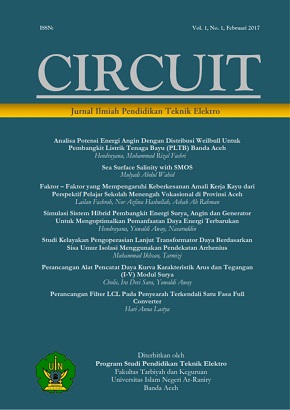Analisis Implementasi Aplikasi Pembelajaran Interaktif Calistung Dengan Pendekatan Technology Acceptance Model
DOI:
https://doi.org/10.22373/crc.v5i2.9725Keywords:
Interactive Learning, Technology Acceptance Model (TAM), PLS-SEMAbstract
The advancement of smartphone technology has an impact in the field of education, especially in application-based interactive learning media. Based on the results of interviews at the Paya Laba Public Elementary School (SDN), some of the students have difficulty in using interactive learning media based on applications, ranging from operating skills, equipment, habits, benefits and others. Thus, to measure the level of acceptance of the use of interactive learning applications for reading, writing and arithmetic skills at SDN Paya Laba culd conducted by using a theoretical method which described the level of technology acceptance, namely the Technology Acceptance Model (TAM). However, the study aims to analyze the implementation of interactive learning reading, writing, arithmetic based on android applications. The test was run by measuring the influence between variables in the TAM model, which labelling as Perceived Ease of Use, Perceived Usefulness, and Attitude towards Using Technology, Behavioral Intention to Use and Actual Technology Use. The data in this study were obtained from questionnaires which filled out by the respondents. The data analyzed with Structural Equation Modeling approach based on Partial Least Square (PLS-SEM) by using the SmartPLS application. The stages of data analysis started from designing the structural model, designing the measurement model, evaluating the measurement model, evaluating the structural model, and testing the hypothesis. From the research results based on the seven proposed hypotheses, there are six hypotheses declared accepted and one hypothesis rejected.
References
A. Suharso, A. A. Hendriadi, and A. Rahmat. (2013). Desain Aplikasi Belajar Membaca Untuk Anak Berbasis Multimedia,” Syntak, vol. 2, pp. 36–44
B. Warista (2011). Pendidikan Jarak Jauh Perancangan, Pengembangan, Implementasi dan Evaluasi. Diklat, 1st ed. Bandung: Remaja Rosdakarya
M. Fathul Mubarak. (2017). Aplikasi Pelaporan Pelayanan Publik Berbasis Android(Studi Kasus Ombudsman Makassar). UIN Alauddin Makassar
A. Muhson (2010). Pengembangan Media Pembelajaran Berbasis Teknologi Informasi. J. Pendidik. Akunt. Indones.,8(2), 1–10
S. Widayati. (2014). Pengembangan Kemampuan Membaca Menulis dan Berhitung (CALISTUNG) Melalui Pendekatan Beyond Center And Circle Time (BCCT) Pada Siswa TK Negeri Pembina Boyolali Tahun Pelajaran 2013/2014. Universitas Muhammadiyah Surakarta
N. K. Ceryna Dewi, I. B. G. Anandita, K. J. Atmaja, and P. W. Aditama. (2018). Rancang Bangun Aplikasi Mobile Siska Berbasis Android. SINTECH (Science Inf. Technol. J). 1(2), 101-
Z. P. Juhara. (2016). Panduan Lengkap Pemograman Android. 1st ed. Yogyakarta: ANDI OFFSET
G. Hamdi., Krisnawati. (2011). Membangun Aplikasi Berbasis Android ‘Pembelajaran Psikotes’ Menggunakan App Inventor. J. Dasi, 12,(4),
J. Hartono. (2007). Sistem Informasi Keperilakuan. Yogyakarta: ANDI
W. Supriyanto., R. Iswandiri. (2017). Kecenderungan Sivitas Akademika Dalam Memilih Sumber Referensi Untuk Penyusunan Karya Tulis Ilmiah Di Perguruan Tinggi. Berk. Ilmu Perpust. dan Inf, 13(1), 82-
U. Narimawati, J. Sarwono, A. Affandy, and S. Priadana. (2020). Ragam Analisis Dalam Metode Penelitian (untuk penulisan skripsi, thesis, dan disertasi). 1st ed. Yogyakarta: ANDI
W. Abdillah and J. Hartono. (2015). Pertial Least Square (PLS) Alternatif Structural Equation Modeling (SEM) Dalam Penelitian Bisnis. 1st ed. Yogyakarta: ANDI
A. S. Hussein. (2015). Penelitian Bisnis dan Manajemen Menggunakan Partial Least Squares dengan SmartPLS 3.0. Univ. Brawijaya, vol. 1, 1–19.
Downloads
Additional Files
Published
Issue
Section
License
Authors who publish in CIRCUIT: Jurnal Ilmiah Pendidikan Teknik Elektro agree to the following terms:
- Authors retain copyright and grant the journal right of first publication with the work licensed under a Creative Commons Attribution-ShareAlike 4.0 International License (CC BY-SA 4.0) that allows others to share and adapt the work with an acknowledgement of the authorship and initial publication in this journal
- Authors are able to enter into separate, additional contractual arrangements for the non-exclusive distribution of the journal's published version of the work (e.g., post it to an institutional repository or publish it in a book), with an acknowledgment of its initial publication in this journal.
- Authors are permitted and encouraged to post their work online (e.g., in institutional repositories or on their website) prior to and during the submission process, as it can lead to productive exchanges, as well as earlier and greater citation of published work. (See The Effect of Open Acces)

